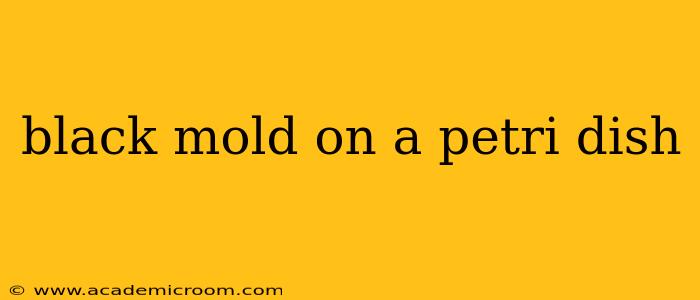Black mold, a term often used colloquially, actually refers to several species of fungi that produce dark-colored spores. Seeing black mold growing on a petri dish, whether in a laboratory setting or unexpectedly at home, raises several important questions about identification, potential health risks, and appropriate safety measures. This article will explore these issues comprehensively.
What Types of Mold Grow on Petri Dishes?
Numerous mold species can grow on a petri dish, depending on the nutrient agar used and the environmental conditions. While "black mold" isn't a specific species, several genera, including Aspergillus, Stachybotrys, and Cladosporium, are common culprits and can exhibit dark pigmentation. Identifying the exact species requires microscopic examination and potentially advanced laboratory techniques. The appearance alone isn't sufficient for definitive identification. Many harmless molds can appear black or dark in color, so visual identification should never be the only factor considered.
Is Black Mold on a Petri Dish Dangerous?
The danger posed by black mold on a petri dish depends entirely on the species present and the exposure level. Some black molds produce mycotoxins—toxic substances that can cause adverse health effects if inhaled or ingested. Stachybotrys chartarum, often called "toxic black mold," is a notable example, known to produce mycotoxins that can trigger allergic reactions and, in severe cases, more serious health problems. However, many other black molds are not inherently toxic and pose minimal risk.
How to Identify Mold on a Petri Dish?
Identifying mold to the species level requires expertise and laboratory equipment. Visual identification alone is unreliable. Microscopic examination, including spore morphology analysis, is crucial for proper identification. Molecular techniques like DNA sequencing may also be employed for accurate species determination. If you encounter unexpected mold growth on a petri dish, it's vital to consult with a mycologist or a qualified microbiologist for proper identification. Never attempt to identify or handle the mold without proper training and safety precautions.
What are the Health Risks Associated with Black Mold?
The health risks associated with black mold exposure vary greatly depending on the species and the individual's sensitivity. Common reactions can range from allergic reactions (such as sneezing, coughing, and itchy eyes) to more severe respiratory problems, particularly in individuals with pre-existing conditions like asthma. In rare cases, exposure to certain mycotoxins can cause more serious health issues. It's crucial to avoid exposure to any mold whose identification is unknown.
How Can I Prevent Mold Growth on Petri Dishes?
Preventing mold growth on petri dishes requires maintaining sterile conditions throughout the entire process. This includes:
- Sterilization: Thorough sterilization of all equipment, including petri dishes, media, and instruments, is crucial.
- Aseptic Technique: Strict adherence to aseptic techniques during inoculation and handling of the petri dishes is essential to minimize contamination.
- Proper Storage: Petri dishes should be stored under appropriate conditions to prevent mold growth. This often involves refrigeration.
- Quick disposal: Dispose of used petri dishes and media properly to prevent contamination.
What Should I Do if I Find Black Mold on a Petri Dish?
If you find black mold on a petri dish in a laboratory setting, follow established protocols for handling biological waste. Dispose of the petri dish according to your institution's guidelines. If you find unexpected mold growth on a petri dish at home, avoid touching it and contact a qualified professional for safe removal and identification. Never attempt to handle or clean up mold yourself without proper protection and knowledge.
This information is for educational purposes only and does not constitute medical or professional advice. Always consult with a qualified professional for any health concerns or if you suspect mold contamination.
